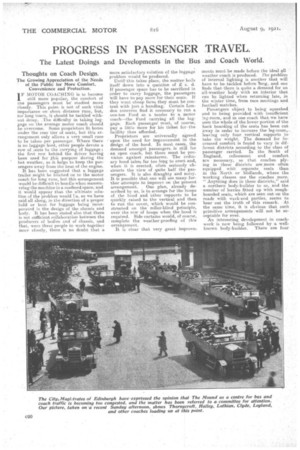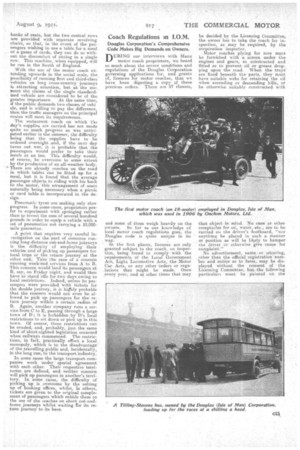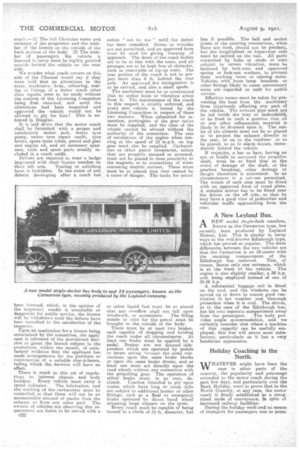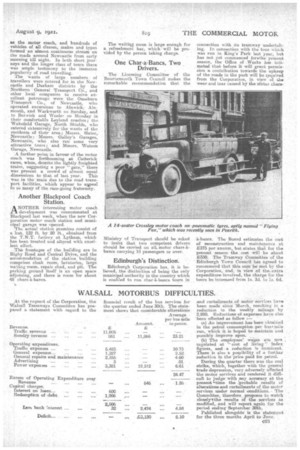PROGRESS IN PASSENGER TRAVEL.
Page 16

Page 17

Page 18

Page 19

If you've noticed an error in this article please click here to report it so we can fix it.
The Latest Doings and Developments in the Bus and Coach World.
Thoughts on Coach Design.
The Growing Appreciation, of the Needs of the Public for More Comfort, Convenience and Protection.
1 IF MOTOR COACHING is to become
still more popular, the comfort of the passengers must be studied more elosely. This point is not of such vital importance on short distance runs, but, for long tours, it should he tackled without delay. The difficulty in taking luggage on the average motor coach should be overcome. Some proprietors fit boxes under the rear tier of seats, but this arrangement only allows a very small case to be taken per passenger. Where there is no luggage boot, other people devote a row of..Leats to the carrying of luggage ; the first row behind the driver having been used for ,this purpose during the hot weather, as it helps to keep the passengers•away from the heat of the engine.
It has been suggested that a luggage trailer might be hitched on to the motor coach for long runs, but this arrangement would bediflicult to handle when mariceuvring the machine in a confined space, and it would appear that the ultimate solution of the problem would lie, as we have said all along, in the direction of a proper bold or boot for luggage being incorporated in the design of the chassis and body. It has been stated also that there is not sufficient collaboration between the producers of bodies and of chassis, and that were these people to work together more closely, there is no doubt that a more satisfactory solution of the luggage problem would be produced. Until this takes place, the matter boils itself down into a question of £ s. d. If passenger space has to be sacrificed in order to carry luggage, the passengers Will have to pay more for their seats. If they want cheap fares they must be content with just a handbag. Certain London concerns find it necessary to run a one-ton Ford :is a tender to a motor coach—the Ford carrying all the luggage. Each passenger must, of course, pay a little more for his ticket forthe facility thus afforded.
Proprietors are universally agreed upon the need for improvement in the design of the hood. In most oases, the demand amongst passengers is still for an open coach, but there must be provision against rainstorms. The ordinary hood takes far too long to erect and, when it is erected, often seriously obstructs the view of quite half, the passengers. It, is also draughty and noisy. It is possible that one will see many further attempts to improve on the present arrangement. One plan, already described by us, is to arrange for the hoops of the Wood and ether supports to he quickly raised to the vertical and then to run the cover, which would be constructed on the roller-blind principle, over the raw of hoops when the hood is required. Side curtains would, of course, complete the weather-proofing .of thia arrangemeut.
Itis clear that very great improve:
ments must be made before the ideal all weather coach is produced. Ile problem of internal lighting is another that will have to be. tackled before long, and one finds that there is quite a demand for an all-weather body with an interior that can be lighted when returning late, in the winter time, from race meetings and football matches.
Passengers object to being squashed. and to being provided with insufficient leg-room, and in one coach that we have seen the whole of the lower portion of the back hoarding of the seats has been cut away in order to increase the leg-room,_ leaving only four vertical supports to take the weight. The demand for Increased comfort is found to vary in different districts according to the class of passenger carried. In the South of England, refinement and comfort are necessary, so that coaches plying in these districts are „more often equipped with separate seats than in the North or Midlands, where the working classes use the coaches more. " Anything does in these districts," said a northern body-builder to us, and the number of lorries fitted up with roughboarded seats, which are seen out on the roads with week-end parties, seems to bear out the truth of this remark. At the same time, it is obvious that such primitive arrangements will not. be acceptable for ever.
An interesting, development in coachwork is now being followed by a wellknown body-builder. There are four banks of seats, but the two central rows. are provided with separate revolving chairs, so that, in the event of the passengers wishing to use a table for a meal , or a game of cards, they can de so without the discomfort of sitting in a single row. This machine, when equipped, will be run in the South of England. With the use of the motor coach extending upwards in the social scale, the possibility of running first and third-class vehicles on long cross-country journeys is attracting attention, but at the mo-, ment the claims of the single standardized vehicle are considered to be of the greater importance. At the same time, if the public demands two classes of vehi cle, and is willing to pay the difference, then the traffic managers on the principal routes will meet its requirements.
The restaurant Coach on which 02•1.3 day's supplies are carried has not made quite so much progress as was anticipated earlier in the summer, the difficulty being that the supplies have to be ordered overnight .and, if the next day turns out wet, it is probable that the passengers would prefer to take their meals at an inn. This difficulty would, of course; be overcome to some extent by the production of an all-weather body. There are already coaches on the road in which -tables can be fitted up for a meal, hut. it is found that the average passenger objects to riding with his back to the motor, this arrangement of seats naturally being necessary when a picnic or card tabla is incorporated in the design.
Pneumatic tyres are making only slow progress. In some cases, proprietors prefer to experiment with springing rather than to invest the sum of several hundred pounds in order to equip a vehicle with a set of pneumatics not carrying a 1,0,C00mile guarantee.
A point that requires very careful in:estigation on the part of concerns running long-distance out-and-home joarn7s is the difficulty of employing' their vehicles and of picking up. passengers for local trips or the return journey at the other end, Take the case of a concern running weekLend services from A to B. This.concern would land its passengers at B, say, On Friday night, and Would .then have to stand idle for two days; owing to local restrictions. Indeed, unless its passengers Were provided With tickets for the double journey, it is highly probable that the concern would not even be allowed to pick up passengers for the return journey within a certain radius of B. Again, another company runs a service from C to E, passing through a large town of D; it is forbidden by D's focal restrictions to set down or pick up in this. town. Of course; these restrictions tan be evaded, and, Probably, just the same kind of 'short-sighted legislation Occurred when railways commenced. The restricthins, in fact, practically effect a loc-al monopoly, which is to the disadvantage of the travelling public and, incidentally, in the long run; to the transport industry.
In some cases the large transport companies work . under' special agreement' with each other. Their respective territories are defined, and neither concern. will pick up passengers in another's tern-. tory. In some cases, the difficulty of picking up is overcome by the setting up of booking offices, whilst, in others, tickets are given to the original complement of passengers which entitle them to the use of the coaches on short out-andhome journeys whilst waiting for its re:turn journey to its base.
Coach Regulations in 1.0.M,
Douglas Corporation's Comprehensive Code Makes Big Demands. on Owners.
DURTNG our interviews with Manx motor coach proprietors, we heard so much about the severe conditions and regulations of the Douglas Corporation governing applications for, and grants of; licences for motor coaches, that we have been digesting a copy of these precious orders. There are 57 clauses,
and some of them weigh heavily on the owners. So far as our knowledge of local motor coach regulations goes, the Douglas code is quite unique in its way. in the first places, licences are only granted subject to the coach, on inspection, being found to comply with the requirements of the LOCia Government Act, Light Locomotive Acts, the.Mbtor Car Acts, or any other Orders or regulations that might be made. Once every year and at other times that may • be decided by the Licensing Committee, the owner has to take the coach for inspection, as may be required, by the corporation inspector. Motor coaches plying for hire 'mist be furnished with a screen under the engines and gears, so constructed and fitted as to prevent oil or grease drop• ping upon the road. When the trays' are fixed beneath the parts, they must have suitable webs for retaining the oil when ascending or descending hills, or be otherwise suitably constructed. with that. object in mind. No cane or other receptacles for oil, water, etc., are to be carried on the driver's footboard, "nor anything be placed in such a manner or position as will be likely to hamper the driver or Otherwise give cause for complaint." No advertisement, name or lettering, other than the official registration number arid notice as to fares, may be displayed without the consent of the Licensing Committee, but the following particulars must be painted oh the coach :—(1) The full Christian name and surname of the proprietor and the number of the licence on the outside of the back portion. of the body: (2) The number of passengers the vehicle is licensed to carry must be legibly painted outside behind the vehicle on the near side. We wonder what coach owners on this side of the Channel would say if they were told that no alterations in the tyres,, machinery, body, colouring, seating or Ettings of a motor coach other than repairs were to be made without the consent of the Licensing Committee being firetobtained, and until the alterations had been inspected and approved the vehicle would not be allowed to ply for hire! This is enlowed in Douglas.
It is laid down that the motor coach shall be furnished with a proper and satisfactory motor jack, motor tyre pump, motor tyre repair outfit, tyre levers, spare inner tubes, petrol and gear and engine oil, and all neeeesiary spanners, tools and spare parts usually included in a coach outfit.
Drivers are required to wear a badge impressed with their licence number on
their left arm. Touting or soliciting fares is forbidden. In the. event of any defects developing after a' coach has
been licensed, which, in the opinion of the inspector, render it unsuitable or dangerous for public service, the licence will be withdrawn until the defects have been remedied to the satisfaction of the inspector.
Upon an application for a licence being entertained by the committee, the applicant is informed of the provisional decision to grant the licence subject to the production, within one month, of satisfactory evidence that the applicant has made arrangements for the purchase or construction of a suitable char-a-banes, failing which the, decision will have no effect.
There is mach in. this set of regulations to interest chassis., and body builders. Every vehicle must carry a
speed indicator. The lubrication, and the working of the carburetter must be controlled so that there will not be an unreasonable amount of smoke from the exhaust or from any other part. The owners of. vehicles not observing this requirement are liable to be served with a
C22
notice " not to use " until the defect has been remedied. Sirens or whistles are not permitted, and an approved horn must be used for giving warning of approach. The doors of the coach bodies are to be in line with the seats, and all passages are to be kept. free of obstacles, such as removable or tip-up seats. The rear portion of the coach is not to project more than 4 ft. behind the rear axle. An approved .fire extinguisher is to be carried, and, also a small spade. The machinerymust be so constructed that no undue noise or vibration arises from it. The maintenance of the coach in this respect is strictly enforced, and every new. vehicle is . tested by the Licensing Committee in respect of these two matters. When submitted for inspection, partieielars of the gear ratios must be supplied, and the sizes of the wheels cannot be altered without the authority of the committee. The rate of revolutions of the engine when running at the speed of 12 m.p.h. on top gear must also be supplied. Carburetters or other petrol receptacles, unless they are properly encased or screened, must not be placed in close proximity to the magneto or to connections of wires conveying electric current. These wires must be so placed that they cannot be a cause of danger. The tanks for petrol
or other liquid fuel must be so placed that any overflow shall not fall upon
woodwork, or accumulate. The filling nozzle or inlet for the petrol must be brought to the outside of the body. There must be at least two brakes, each capable of stopping and holding the coach under all circumstances. At leastone brake must be applied by a pedal. Brakes are not deemed independent which are operated by pedals cc levers actingt hrough the same Connections upon the same brake blocks or upon the same brake drums, and at least, one must act directly upon the road wheels without any connection with the propelling gear. The operation of either lorieke must, in no case, declutch. Coaches intended to ply upon routes which have long or steep hills are subject. to additional brakes or other fittings, such as a final or emergency brake operated by direct hand wheel actuating large slippers on the tyres.
Every coach must be capable of being turned in a circle of 55 ft. diameter, but
less if possible. The ball, and eocket joints of the steering connections, when these ale used, should not be pendant, but the longitudinal or transverse rods must be carried on the ball, All parts connected by bolts or studs or nuts subject to severe vibration, must be fastened by lock-nuts and approved spring or look-nut washers, to prevent their working loose or causing noise. Vehicles with loose lamp brackets or other fittings likely to cause unnecessary noise are 'regarded as unfit for public service. Effective means must he taken for preventing the heat from the machinery from injuriously affecting any part of the vehicle. The exhaust pipe must not be led inside the tray or undershield) or be fixed in such a position that oil or. any other inflammable material is likely to be dropned upon it. The outlet of the silencer must not be so placed as to project the exhaust directly to the rear, or onto the roadway or to be placed, so as to alarm horses, immediately behind the vehicle. If requisite, a bar or bars, having an eye or bridle to surround the propeller shaft, must be so fixed that in the event of damage of the shaft, or the gearbox breaking, other damage or danger therefrom is minimized. In no circumstances is a cut-out permitted. The treads of each step must be fitted with an approved form of tread plate. A suitable mirror has to be fitted near the driver on the off side, so that he may have a good view of pedestrian and vehicular traffic approaching from the rear.
A New Leyland Bus.
ANEW model single-deck omnibus, known as the Carnarvon type, has recently been produced by Leyland Motore, Ltd. • This i.e. similar in many ways to the well-known Edinburgh type, which. has proved so popular. The main differen6es between the two vehicles are that the Carnarvon is en 18-seater with the smoking 'compartment of the Edinburgh bus removed. This, of course, leaves only one, entrance, which is at the front of -the vehicle. The engine is also slightly smaller, a 30 hp. unit being employed instead of one of 30-36 h.p. A substantial luggage rail is flitted on the roof, and the windows can be moved up or down to ensure good ventilation in hot weather end thorough. protection when it is cold. The driver, as in the case of the Edinburgh bug, bete his own separate compartment away from the passengers. The body pros-ides ample accommodation, and we certainly consider that where a machine of this capacity can be usefully employed, this bus will prove most satisfactory, particularly es it has a very handsome appearance.
Holiday Coaching in the North.
WFIATEVER might have been the case in other parts of the country, the popularity and patronage extended to the motor coach during the past few days, and particularly over the Bank Holiday, went to prove that in the North country, at any rate, the motor coach is firmly established as a recognized mede of conveyance, in spite of increased railway facilities.. During the holiday week-end no means of transport for passengers was so popu
as the motor coach, and hundreds of vehicles of all classes, makes and types formed an almost continuous stream on the roads around Newcastle from early morning till night. In both short Jour• nays and the longer class of tours there was ample testimony to the immense popularity of road travelling. The 'wants of large numbers of travellers were catered for in the Newcastle and Durham districts by the Northern General Transport Co., and other local companies to receive excellent patronage; were the Ouseburn Transport Co., of Newcastle, who operated excursions to Alnwick. Alnmouth, and Warkworth on Sunday, and to Berwick and Woolea on Monday in their comfortable Leyland coaches; the Wakefield Garage, North. Shields, who catered ostensively for the wants of the residents of their area Messrs. Slater, Newcastle; Messrs. Galley's Garages, Newcastle, who also ran some very attractive tours; and Messrs. Watson Garage, Newcastle.
A further point in favour of the motor coach was forthcoming at Catterick races, when, despite the lightly freighted trains, suggesting a poor 'gate," there was present a crowd of almost equal dimensions to that of last year This -was in the main due to the read transport facilities, which appear to weal to so many of the race-going fraternity.
Another Blackpool Coach Station.
ANOTIIER interesting motor coach development was consummated at Blackpool last week, when the new Corporation motor coach station and municipal garage was opened.
The actual station premises consist of a hut, 122 ft. by 20 ft., obtained from the T.N.T. factory at Lytham, which has been treated and altered with excellent effect.
The frontages of the building are iit Rigby Read and Central Drive, and the accommodation of the station building comprises cloak room, lavatories, large waning room, repair shed, and pit. The parking ground itself is an open space adjoining, and there is room for about 48 chars-aebanes. The waiting room is large enough for a tefreshment bar, which will be provided by the person taking charge.
One Char-a-Bancs, Two Drivers. .
The Licensing Committee of the Bournemouth Town Council makes the remarkable recommendation that the Ministry of Transport should be asked to insist that two competent drivers should be carried on all, motor chars-b.banes carrying 18 passengers or over.
Edinburgh's Distinction.
Edinburgh Corporation has, it is believed, the distinction of being the only municipal authority in the country which is enabled to run char-babancs tours in
connection with its tramway undertaking. In connection with the tour which was von in King's 'Park last year, but has not yet. commenced for4thepresent season, the Office of Works has intimated that before it will _grant permission a contribution towards the upkeep of the roads in the park will be required from the Corporation, in view of the wear and tear caused by the nietor chars it-bancs. The Board estimates the coat of reconstruction and maintenance at 2375 per annum, but states that for the present season the cost will be about £350. The Tramway Committee of the Edinburgh Town Council has agreed to recommend that this sum be met by the Corporation, and, in view of the:extra expenditure involved, the charge for the tours be increased from Is. 3d, to is. 6d.
































